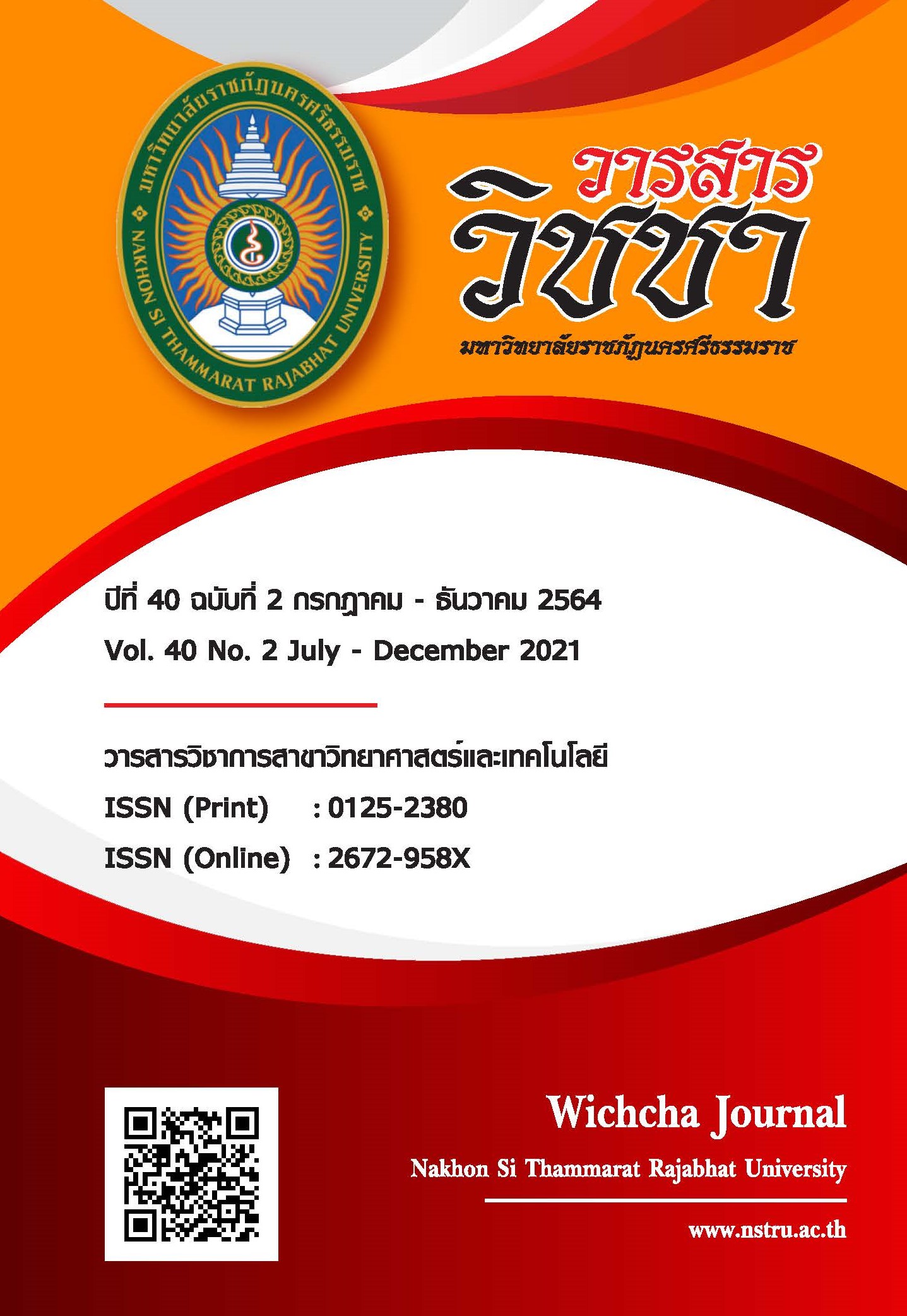The Production Conditions of Nata from Banana Syrup by Acetobacter sp. TISTR 1014 สภาวะการผลิตวุ้นสวรรค์จากไซรัปกล้วยน้ำว้า โดย Acetobecter sp. TISTR 1014
Main Article Content
Abstract
Bananas (Musa sapientum L.) are very productive in Thailand. In the ripening period of bananas, the flesh is soft and will begin to rot within 2-3 days. In this period, the sugar content in the banana is very high; therefore, the overripe banana is utilized to produce banana syrup. In addition, the utilization of syrup extends to produce cellulose or Nata by Acetobacter sp. TISTR 1014. This research studied total dissolved solids (11, 18, and 26 °Brix) that affected microbial growth and cellulose production. The results found that the growth conditions of Acetobacter sp. TISTR 1014 was 11 °Brix under pH 4.2, ammonium sulfate 0.5% (m/v) and the concentration of the initial inoculum was 10% (v/v). The fermentation period was 7 days at 30°C, which is the highest quality of cellulose production. The thickness was 1.13±0.15 cm. L* was 52.16±0.02, a* was -3.16±0.05 and b* was 0.42±0.29. The chewiness of total dissolved solids at 11 °Brix was highest significantly (p ≤ 0.05). Therefore, the utilization of syrup extends to produce cellulose. Cellulose can be used as an ingredient in many kinds of food such as dessert, yogurt, and ice cream, which is an alternative to add value to the overripe bananas.
Article Details
เนื้อหาและข้อมูลในบทความที่ลงตีพิมพ์ในวารสารวิชชา มหาวิทยาลัยราชภัฏนครศรีธรรมราช ถือเป็นข้อคิดเห็นและความรับผิดชอบของผู้เขียนบทความโดยตรง ซึ่งกองบรรณาธิการวารสารไม่จำเป็นต้องเห็นด้วยหรือร่วมรับผิดชอบใด ๆ
บทความ ข้อมูล เนื้อหา รูปภาพ ฯลฯ ที่ได้รับการตีพิมพ์ในวารสารวิชชา มหาวิทยาลัยราชภัฏนครศรีธรรมราช ถือเป็นลิขสิทธ์ของวารสารวิชชา มหาวิทยาลัยราชภัฏนครศรีธรรมราช หากบุคคลหรือหน่วยงานใดต้องการนำข้อมูลทั้งหมดหรือส่วนหนึ่งส่วนใดไปเผยแพร่ต่อหรือเพื่อการกระทำการใด ๆ จะต้องได้รับอนุญาตเป็นลายลักษณ์อักษรจากวารสารวิชชา มหาวิทยาลัยราชภัฏนครศรีธรรมราชก่อนเท่านั้น
The content and information in the article published in Wichcha journal Nakhon Si Thammarat Rajabhat University, It is the opinion and responsibility of the author of the article. The editorial journals do not need to agree. Or share any responsibility.
References
กรมวิชาการเกษตร. (2563). รายงานพิเศษ : โชว์กล้วยน้ำว้าพันธุ์ใหม่‘สุโขทัย1’ ให้ผลผลิตสูง-คุณค่าทางโภชนาการชนะเลิศ. สืบค้นเมื่อ 24 พฤศจิกายน 2563, จาก: https://www.naewna.com/local/469317.
กมลทิพย์ นิคมรัตน์. (2564). การพัฒนาเครื่องดื่มน้ำนมผสมไซรัปกล้วยน้ำว้า. ใน การประชุมวิชาการระดับชาติมหาวิทยาลัยทักษิณ ครั้งที่ 31 (หน้า 1131-1138). สงขลา: มหาวิทยาลัยทักษิณ.
จินตนา พรมวงษ์ป้อ วนิดา โยคนิตย์ และจุฬาลักษณ์ เขมาชีวะกุล. (2560). การศึกษาสภาวะที่เหมาะสมในกระบวนการหมักเพื่อผลิตวุ้นด้วย Acetobacter xylinum TISTR 975 จากน้ำมะม่วง. วารสารวิจัยและพัฒนา มจธ., 40(2), 271-282.
จีราภรณ์ สังข์ผุด และฉัตรชัย สังข์ผุด. (2557). การผลิตเส้นใยเซลลูโลสด้วยน้ำหวานต้นจาก. วารสารวิชชา มหาวิทยาลัยราชภัฏนครศรีธรรมราช, 33(2), 60-71.
จุฬาลักษณ์ เขมาชีวะกุล. (2559). การผลิตแบคทีเรียเซลลูโลสสายพันธุ์ Acetobacter xylinum และการประยุกต์ใช้ในอุตสาหกรรม. การเกษตรราชภัฏ, 15(2), 25-33.
ปราโมทย์ ธรรมรัตน์. (2546). ประสบการณ์วิจัยพัฒนาวุ้นมะพร้าวและวุ้นสวรรค์ครบวงจร. ประชาคมวิจัย. 50, 7-9.
ธิดารัตน์ เทพรัตน์. (2559). การผลิตไซรัปกล้วยน้ำว้า. วารสารวิชาการปทุมวัน, 6(16), 7-14.
ภูมิพงษ์ ชูช่วยสุวรรณ เทพปัญญา เจริญรัตน์ สุเปญญา จิตตพันธ์ และนวลกมล อำนวนสิน. (2563). การพยากรณ์ระยะสุกของกล้วยหอมทองโดยใช้การถดถอยของวิธีกำลังสองน้อยที่สุดบางส่วน. Thai Journal of Science and Technology, 9(2), 287-297.
วิจิตรา ใหม่จันทร์ พิชามญชุ์ กำมังละการ สุวรรณา สุดปรึก กุลนันท์ ปุ๊ดพรหม ชุติมา อันชนะ จันทร์ทิมา พงษ์พานิช และสุรศักดิ์ ละลอกน้ำ. (2555). การผลิตเซลลูโลสจากแบคทีเรีย Acetobacter xylinum TISTR 086 โดยใช้ผลผลิตทางการเกษตรเป็นแหล่งคาร์บอน. วารสารหน่วยวิจัยวิทยาศาสตร์ เทคโนโลยี และสิ่งแวดล้อมเอการเรียนรู้. 3(2), 92-97.
ศยามพงษ์ พงษ์ดำ. (2560). การหายใจระดับเซลล์ของแบคทีเรียกรดอะซิติก: การหมักแบบออกซิเดทีฟและการประยุกต์ใช้. วารสารวิจัย มสด, 10(3), 203-236.
อนันต์ บุญปาน สิริแข พงษ์สวัสดิ์ และจิรพรรณ คำผา. (2553). การศึกษาสภาวะที่เหมาะสมในการผลิตวุ้นสวรรค์จากกากน้ำตาล. ใน ประชุมวิชาการมหาวิทยาลัยเกษตรศาสตร์ ครั้งที่ 48 (หน้า 547-554). กรุงเทพฯ: มหาวิทยาลัยเกษตรศาสตร์.
Cook, N.C. and Samman, S. (1996). Flavonoids-Chemistry, metabolism, cardioprotective effects, and dietary sources. The Journal of Nutritional Biochemistry. 7(2), 66-76.
Jagannath, A., Kalaiselven, A., Manjunatha, P.S. and Bawa, A.S. (2008). The effect of pH, sucrose and ammonium sulphate concentrations on the production of bacterial cellulose (Nata-de-coco) by Acetobacter xylinum. World Journal of Microbiology and Biotechnology, 24(11), 2593-2599.
Raghunathan, D. (2013). Production of microbial cellulose from the new bacterial strain isolated from temple wash waters. International Journal of Current Microbiology and Applied Sciences, 2(12), 275-290.
Trisnaputri, A.C., Usman, N.R., Mustawa, M.A. and Jaya, A.M. (2018). Production banana glucose syrup with the α-amylase supplementation. International Journal of Applied Biology, 2(1), 61-65.


